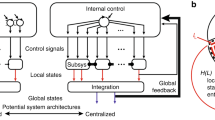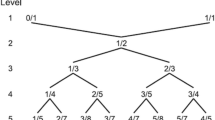Abstract
This paper outlines and applies a synergetic strategy to the coordination of human rhythmical movement. It extends earlier empirical and theoretical work to include the influence of specific environmental information and of memory on the dynamics of the collective variables (order parameters) that characterize the coordination patterns. Key ideas concern cooperative and competitive influences on the collective dynamics. Recent experiments on environmentally specific and learned rhythmic movement patterns are modeled explicitly on the level of the collective variable, relative phase. New predictions are presented and research directions proposed that follow directly from the present theoretical approach.
Similar content being viewed by others
References
Gibson JJ (1950) The perception of the visual world. Houghton Mifflin, Boston, Mass
Haken H (1983) Synergetics: an introduction. Nonequilibrium phase transitions and self-organization in physics, chemistry, and biology, 3rd edn. Springer, Berlin Heidelberg New York
Haken H, Kelso JAS, Bunz H (1985) A theoretical model of phase transitions in human bimanual coordination. Biol Cybern 51:347–356
Herman R, Grillner S, Stein PSG, Stuart DG (eds) (1976) Neural control of locomotion. Plenum Press, New York
Holst E von (1939/1973) Relative coordination as a phenomenon and as a method of analysis of central nervous function. Reprinted in: The collected papers of Erich von Holst, University of Miami Press, Coral Gables, Fla
Kay BA, Kelso JAS, Saltzman EL, Schöner G (1987) Space-time behavior of single and bimanual rhythmic movements: data and limit cycle model. J Exp Psych: Hum Perc Perf 13:178–192
Kelso JAS (1981) On the oscillatory basis of movement. Bull Psychon Soc18:63
Kelso JAS (1984) Phase transitions and critical behavior in human bimanual coordination. Am J Physiol: Reg Integ Comp 15:R1000-R1004
Kelso JAS, Schöner G (1987a) Toward a physical (synergetic) theory of biological coordination. In: Graham R, Wunderlin A (eds) Lasers and synergetics. Springer Series in Physics. Springer, Berlin Heidelberg New York
Kelso JAS, Schöner G (1987b) Self-organization of coordinative movement patterns. J Hum Mov Sci (to be published)
Kelso JAS, Scholz JP (1985) Cooperative phenomena in biological motion. In: Haken H (ed) Complex systems — operational approaches in neurobiology, physical systems and computers. Springer, Berlin Heidelberg New York, pp 124–149
Kelso JAS, Tuller B (1987) Intrinsic time in speech production: theory, methodology, and preliminary observations. In: Keller E, Gopnik M (eds) Motor and sensory processes of language. Erlbaum, Hillsdale, NJ, pp 203–222
Kelso JAS, Southard DL, Goodman D (1979) On the nature of human interlimb coordination. Science 203:1029–1031
Kelso JAS, Scholz JP, Schöner G (1986) Nonequilibrium phase transitions in coordinated biological motion: critical fluctuations. Phys Lett A 118:279–284
Kelso JAS, Schöner G, Scholz JP, Haken H (1987) Phase-locked modes, phase transitions and component oscillators in biological motion. Phys Scr 35:79–87
Kristan WB (1980) Generation of rhythmic motor patterns. In: Pinsker HM, Willis WD (eds) Information processing in the nervous systems. Raven Press, New York
Lee DN, Young DS (1986) Gearing action to environment. In: Heuer H, Fromm C (eds) Generation and modulation of action patterns, Experimental Brain Research Series, vol 15. Springer, Berlin Heidelberg New York
Reichardt WE, Poggio T (eds) (1981) Theoretical approaches in neurobiology. MIT Press, Cambridge, Mass
Schöner G, Kelso JAS (1988) A synergetic theory of environmentally-specified and learned patterns of movement coordination. II. Component oscillator dynamics. Biol Cybern 58:81–89
Schöner G, Haken H, Kelso JAS (1986) A stochastic theory of phase transitions in human hand movement. Biol Cybern 53:247–257
Scholz JP, Kelso JAS, Schöner G (1987) Nonequilibrium phase transitions in coordinated biological motion: critical slowing down and switching time. Phys Lett A123:390–394
Soechting JP, Terzuolo CA (1986) An algorithm for the generation of curvilinear wrist motion in an arbitrary plane in three-dimensional space. Neuroscience 19:1393–1405
Tuller B, Kelso JAS (1985) Coordination in normal and split-brain patients. Paper presented at Psychonomic Society. Boston, Mass
Tuller B, Kelso JAS (1987) Environmentally-elicited patterns of movement coordination in normal and split-brain subjects. Exp Brain Res (submitted for publication)
Turvey MT (1977) Preliminaries to a theory of action with reference to vision. In: Shaw R, Bransford J (eds) Perceiving, acting and knowing: toward an ecological psychology. Erlbaum, Hillsdale, NJ
Yamanishi J, Kawato M, Suzuki R (1980) Two coupled oscillators as a model for the coordinated finger tapping by both hands. Biol Cybern 37:219–225
Author information
Authors and Affiliations
Rights and permissions
About this article
Cite this article
Schöner, G., Kelso, J.A.S. A synergetic theory of environmentally-specified and learned patterns of movement coordination. Biol. Cybern. 58, 71–80 (1988). https://doi.org/10.1007/BF00364153
Received:
Accepted:
Issue Date:
DOI: https://doi.org/10.1007/BF00364153




